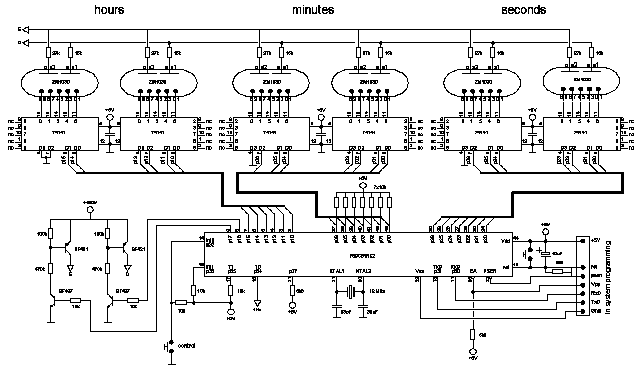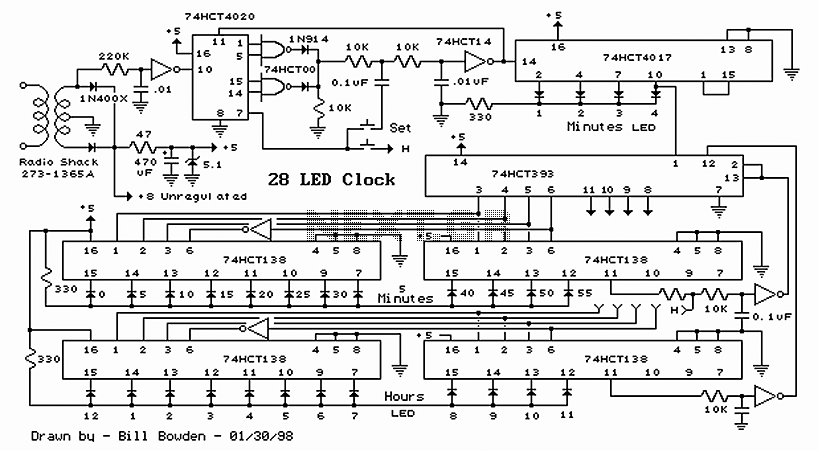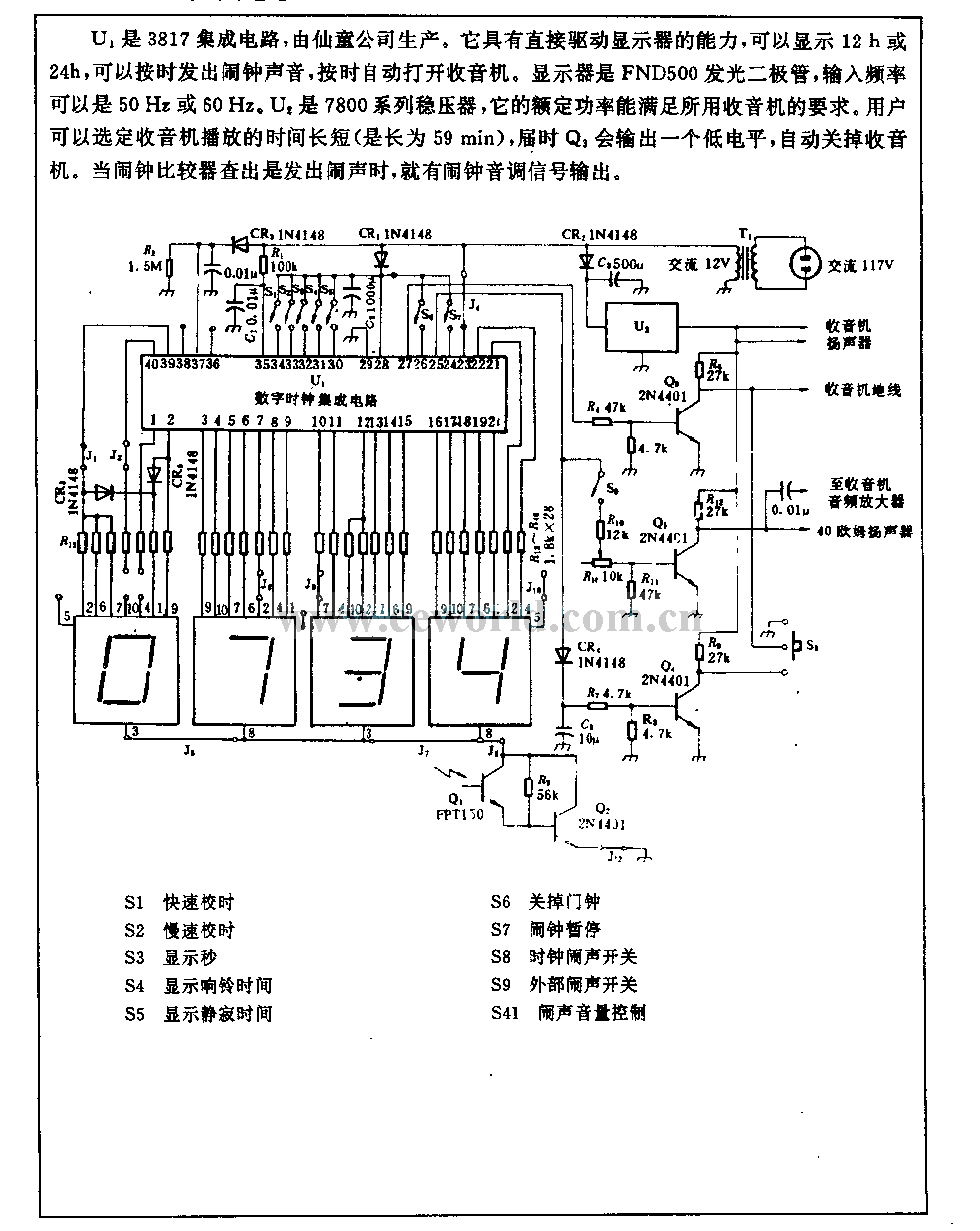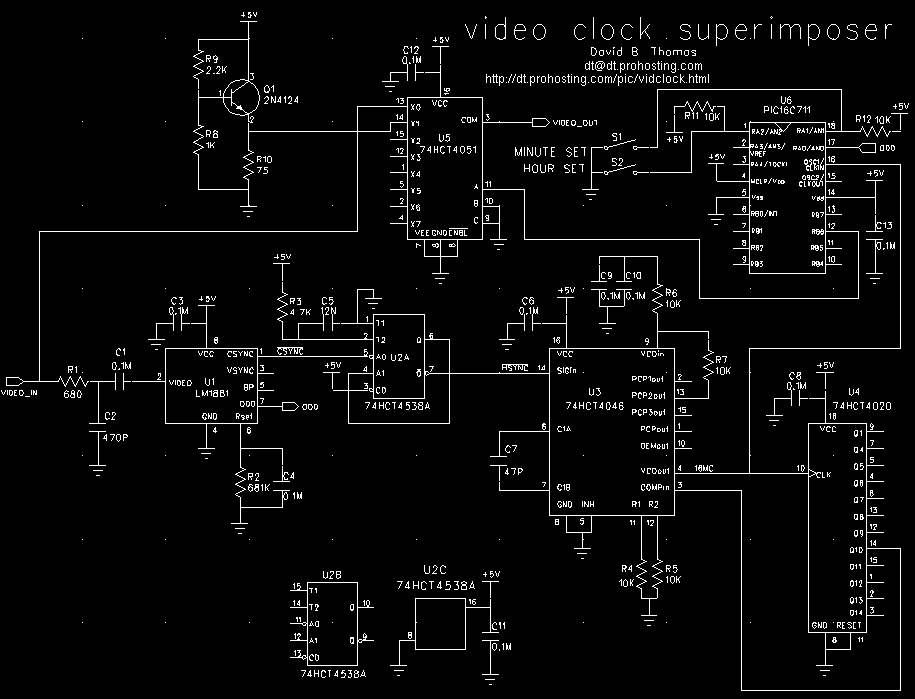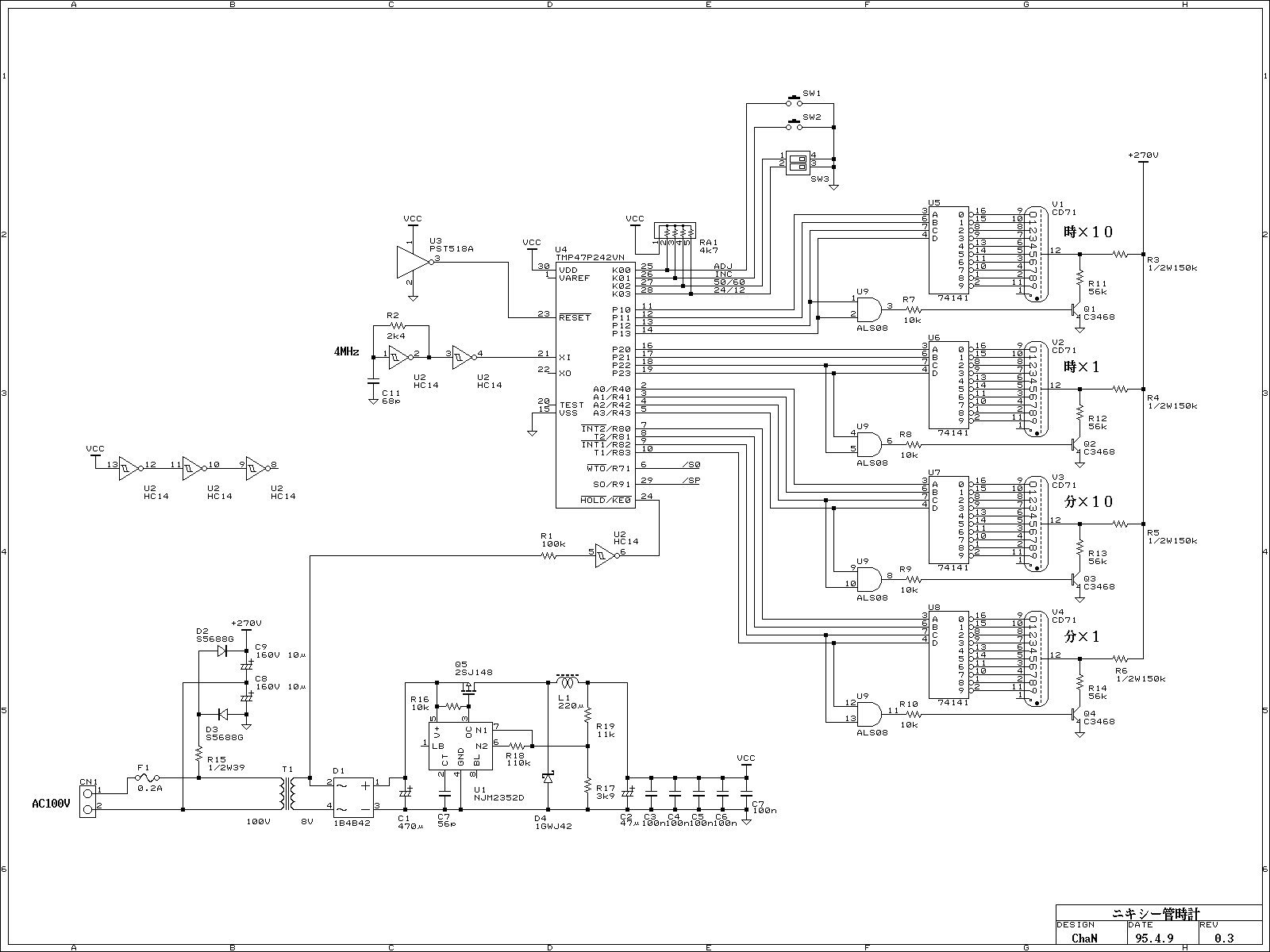
Experimental Pendulum Clock
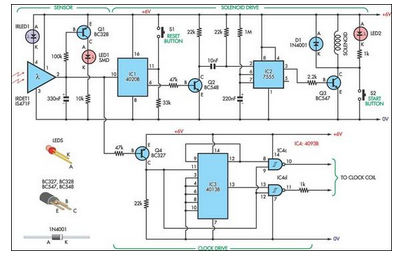
This design allows for the construction of an electromagnetically impulsed pendulum clock with a 1-second beat. The prototype features a pendulum rod measuring 115 cm in length, with a bob adjusted to achieve a 1-second beat. It is suspended from a short piece of mainspring from a watch, which is secured to a vertical backboard using a 6 mm screw. The rod extends approximately 15 cm below the bob and is equipped with large washers at the lower end. For the pendulum to achieve a 1-second beat, a distance of 99.4 cm must be maintained between the support and the center of mass of the pendulum. Positioned between the bob and the lower end is a 5 mm wide white reflector facing backward. Below the rod and 15 mm to the left, an impulse solenoid is located, featuring a core but lacking an actuator. The circuit consists of four main components: (1) the sensor; (2) the counter and solenoid driver; (3) the clock driver; and (4) the clock itself. The sensor is mounted on a small strip board and is aligned with the center line of the backboard behind the reflector. It employs a Sharp IS471F infrared modulated detector (Farnell cat. 414-2860) to minimize interference from external light sources. The infrared emitter (IRLED1) should be positioned close to the detector (IRDET1) but shielded from it. The emitter transmits a coded signal toward the reflector, and as the pendulum passes the center line, it reflects the signal back to the detector, generating a negative-going output pulse on pin 2. This pulse causes the surface-mount LED (LED1) to flash once and sends a signal to the counter and clock driver circuits on the main circuit board. The sensor's output pulses are input into IC1, a 4020 14-stage ripple counter. The counter's output (pin 6) goes high every 128 counts (seconds). These long-duration pulses are inverted by transistor Q1 and differentiated by a 10 nF capacitor and a 22 kΩ resistor, creating a narrow trigger pulse for a 7555 CMOS timer (IC2) configured as a monostable. This timer drives the base of transistor Q3 with a relatively short pulse width, suitable for energizing the impulse solenoid. LED2 flashes in synchrony with the solenoid pulses and can be mounted directly on the solenoid for visual indication. A pushbutton switch (S2) provides gentle starting pulses to initiate smooth pendulum movement. Switch S1 resets the counter to zero. With this setup, the pendulum is set in motion, and when it is to the left of center, pressing S1 allows it to move right to left on even-numbered counts. At the 128th count, the solenoid delivers a gentle pull to the left as the pendulum passes through the center line and moves right to left. The solenoid's position below the pendulum is adjusted to ensure it provides a gentle nudge rather than a jerking motion. The clock driver circuit also derives timing from the sensor output. Negative-going pulses from the sensor are inverted by Q4 before being fed into a 4013 flip-flop. On the output side, pins 12 and 13 go high alternately for one second. These pulses are too lengthy to directly drive the clock coil, so they are logically ANDed with the short pulses from the sensor using two gates from a 4093 NAND Schmitt trigger (IC4). The outputs from these gates then drive an adapted quartz clock movement. A standard quartz movement can be modified for this purpose by isolating the coil and removing the battery. Refer to SILICON CHIP, Dec. 1996, page 38 for detailed instructions or October 2001, page 37 for brief notes. Being an experimental clock, various solenoids may need to be tested to find one that works optimally. If necessary, the solenoid pulse duration can be adjusted by varying the timing components of IC2. If the suspension is too rigid, consider impulsing at 64 beats from pin 4 of IC1; however, the goal remains to achieve the freest pendulum movement possible. Historical clocks like the Synchronome and Hipp were impulsed at 30-second intervals, suggesting potential for improved performance in this design. In the prototype, the reflector was constructed from the back.Using this design, you can construct an electromagnetically impulsed pendulum clock with a 1-second beat. On the prototype, the pendulum rod is 115cm long with a bob adjusted to make it beat every second. It is suspended on a short piece of mainspring from a watch, which is attached to a vertical backboard with a 6mm screw.
The rod extends some 15 cm below the bob and is fitted with large washes at the lower end. Note that for a pendulum to beat in seconds, there must be 99. 4cm distance between the support and the centre of mass of the pendulum. Between the bob and the lower end is a 5mm wide white reflector facing back. Below the rod and 15mm to the left is the impulse solenoid, with a core but no actuator attached. The circuit comprises of four parts: (1) the sensor; (2) the counter and solenoid driver; (3) the clock driver; and (4) the clock. The sensor is built on its own small piece of strip board and is located on the centre line of the backboard behind the reflector.
It utilises a Sharp IS471F infrared modulated detector (Farnell cat. 414-2860) to eliminate interference from external light sources. The infrared emitter (IRLED1) must be mounted near to the detector (IRDET1) but be masked from it. The emitter radiates a coded signal toward the reflector. As the pendulum passes the centre line it reflects the signal back to the detector, which then gives a negative-going output pulse on pin 2. This makes the surface-mount LED (LED1) flash once. It also sends a signal to the counter and clock driver circuits on the main circuit board. Pulses from the sensor are fed into IC1, a 4020 14-stage ripple counter. The counter`s output (pin 6) goes high every 128 counts (seconds). These long duration pulses are inverted by transistor Q1 and differentiated by the 10nF capacitor and 22kO resistor, providing a narrow trigger pulse for a 7555 CMOS timer (IC2).
The 7555 is wired as a monostable, driving the base of transistor Q3 with a relatively short pulse width suitable for energising the impulse solenoid. LED2 flashes in unison with solenoid pulses, and can be mounted right on the solenoid as a visual aid.
Pushbutton switch S2 is used to provide gentle starting pulses to get the pendulum swinging smoothly at the outset. Switch S1 resets the counter to zero. With this arrangement, the pendulum is set swinging and when it is to the left of centre, S1is pushed.
Thus, the pendulum moves right to left on even numbered counts. At the 128th count, the solenoid gives a shot pull to the left just as the pendulum is passing through the centre line and moving right to left. The distance of the solenoid below the pendulum is adjusted so that it does not jerk the pendulum but adds a gentle nudge.
The clock driver circuit also derives its timing from the output of the sensor. Negative-going pulses from the sensor are inverted by Q4 before being fed into a 4013 flipflop. On the output side, pins 12 & 13 go high in turn for one second. These pulses are too long to directly drive the clock coil, so they`re logically anded with the short pulses from the sensor using two gates of a 4093 NAND Schmitt trigger (IC4). The outputs from these gates then drive an adapted quartz clock movement. A suitable clock can be made from a standard quartz movement by isolating the coil and removing the battery.
See SILICON CHIP, Dec. 1996, page 38 for full instructions or October 2001 page 37 for brief notes. This is an experimental clock so you may have to try various solenoids to find one that works for you. If necessary, the solenoid pulse duration can be changed by varying IC2`s timing components. If the suspension is too stiff, try impulsing at 64 beats from pin 4 of IC1, but note that the aim is to get the freest pendulum movement possible.
The Synchronome and Hipp clocks were impulsed at 30-second intervals, so your clock could be even better. In the prototype, the reflector was made from the back 🔗 External reference
The rod extends some 15 cm below the bob and is fitted with large washes at the lower end. Note that for a pendulum to beat in seconds, there must be 99. 4cm distance between the support and the centre of mass of the pendulum. Between the bob and the lower end is a 5mm wide white reflector facing back. Below the rod and 15mm to the left is the impulse solenoid, with a core but no actuator attached. The circuit comprises of four parts: (1) the sensor; (2) the counter and solenoid driver; (3) the clock driver; and (4) the clock. The sensor is built on its own small piece of strip board and is located on the centre line of the backboard behind the reflector.
It utilises a Sharp IS471F infrared modulated detector (Farnell cat. 414-2860) to eliminate interference from external light sources. The infrared emitter (IRLED1) must be mounted near to the detector (IRDET1) but be masked from it. The emitter radiates a coded signal toward the reflector. As the pendulum passes the centre line it reflects the signal back to the detector, which then gives a negative-going output pulse on pin 2. This makes the surface-mount LED (LED1) flash once. It also sends a signal to the counter and clock driver circuits on the main circuit board. Pulses from the sensor are fed into IC1, a 4020 14-stage ripple counter. The counter`s output (pin 6) goes high every 128 counts (seconds). These long duration pulses are inverted by transistor Q1 and differentiated by the 10nF capacitor and 22kO resistor, providing a narrow trigger pulse for a 7555 CMOS timer (IC2).
The 7555 is wired as a monostable, driving the base of transistor Q3 with a relatively short pulse width suitable for energising the impulse solenoid. LED2 flashes in unison with solenoid pulses, and can be mounted right on the solenoid as a visual aid.
Pushbutton switch S2 is used to provide gentle starting pulses to get the pendulum swinging smoothly at the outset. Switch S1 resets the counter to zero. With this arrangement, the pendulum is set swinging and when it is to the left of centre, S1is pushed.
Thus, the pendulum moves right to left on even numbered counts. At the 128th count, the solenoid gives a shot pull to the left just as the pendulum is passing through the centre line and moving right to left. The distance of the solenoid below the pendulum is adjusted so that it does not jerk the pendulum but adds a gentle nudge.
The clock driver circuit also derives its timing from the output of the sensor. Negative-going pulses from the sensor are inverted by Q4 before being fed into a 4013 flipflop. On the output side, pins 12 & 13 go high in turn for one second. These pulses are too long to directly drive the clock coil, so they`re logically anded with the short pulses from the sensor using two gates of a 4093 NAND Schmitt trigger (IC4). The outputs from these gates then drive an adapted quartz clock movement. A suitable clock can be made from a standard quartz movement by isolating the coil and removing the battery.
See SILICON CHIP, Dec. 1996, page 38 for full instructions or October 2001 page 37 for brief notes. This is an experimental clock so you may have to try various solenoids to find one that works for you. If necessary, the solenoid pulse duration can be changed by varying IC2`s timing components. If the suspension is too stiff, try impulsing at 64 beats from pin 4 of IC1, but note that the aim is to get the freest pendulum movement possible.
The Synchronome and Hipp clocks were impulsed at 30-second intervals, so your clock could be even better. In the prototype, the reflector was made from the back 🔗 External reference
